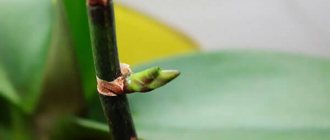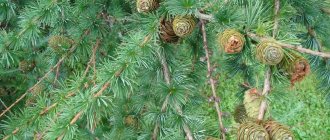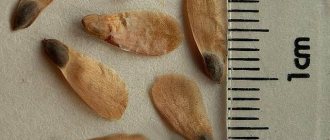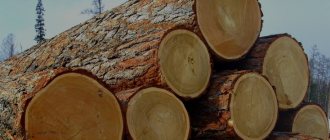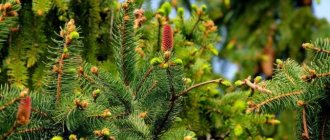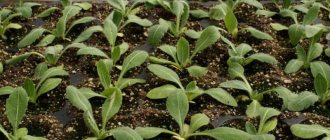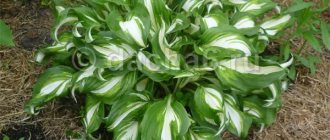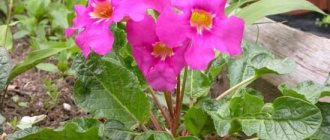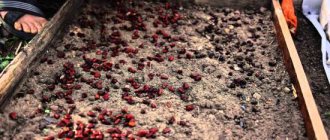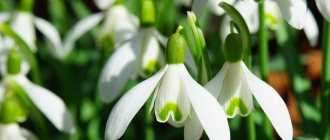Loading... Among coniferous trees, larch occupies a special place.
In appearance, it does not stand out among its relatives and pleases the eye with lush green needles. But there is one caveat: they fall off in the winter. So it turns out that coniferous larch is a deciduous crop. But it has other advantages: the tree is able to grow where others cannot survive. It is not afraid of wet and acidic soils, and some species even thrive in partial shade. The tree is not afraid of drafts, frost and sudden temperature changes. It rarely gets sick, and annual growth can reach 1 m. However, this unpretentious crop still has some nuances of cultivation, and they relate to reproduction. Unlike most conifers, larch does not respond well to cuttings, but it is well planted with seeds. Knowing the subtleties of how larch reproduces, you can avoid annoying mistakes and get a good result. So, larch can be propagated only by two methods:
- sowing seeds for seedlings;
- rooting the cuttings.
Let's take a closer look at each method.
As for cuttings, this method is almost never used for larch due to its ineffectiveness. Cuttings take root extremely reluctantly and rarely, so there is no point in messing with them. It will be much more effective to sow seeds or dig in cuttings.
Methods for propagating larch at home
Larch is unique and completely unpretentious to climatic conditions. It has good resistance to low temperatures in winter and high temperatures in summer, and feels great in the concrete jungle. The plant, which is not picky about soil composition, requires good lighting. Green spaces, widely found in European countries, have gained popularity in our country. Domestic gardeners gave particular preference to the Siberian variety of the plant. For those who are planning to acquire this miracle at their summer cottage, let's talk about ways to reproduce it.
Larch propagation by cuttings
Propagation of larch seems possible by two methods - growing a sprout from seeds, or propagating planting material by cuttings. The easiest and most effective method is propagation by larch cuttings. First you need to cut rods approximately 12 cm long.
You should focus on the workpiece material. Cuttings should be cut from healthy branches, as they subsequently take root poorly and will grow very slowly. When rooting larch branches into the ground, to preserve juice and nutrients, it is time to make a small cut in the bark, from which roots will subsequently grow.
After the roots appear on the branches, the planting material should be moved to the soil substrate in the open ground, and it is important to take into account the requirements for planting - maximum lighting and drainage, which saves the tree from stagnant moisture. The advantage of propagating coniferous trees by cuttings is the possibility of planting the cuttings immediately in open soil. Further care for young animals comes down to moderate watering. In the same way, young shoots can be grafted onto already grown shrubby larches.
Propagation of larch by seeds
Many gardeners wonder how to grow larch from collected seeds. The entire propagation process is, of course, labor-intensive, but the result will certainly please you with the young shoots of this amazing coniferous beauty. So, in order to grow larch from a cone, you need to collect the material required for the work - the cones themselves.
How to grow larch from a branch - Cottage, garden, vegetable garden, indoor plants
Larch is a common decorative coniferous tree, most popular in Russia. This is a monoecious plant, the only one among conifers that sheds its needles before the onset of cold weather.
With good care in favorable conditions, it develops to a height of up to 50 meters, but there are dwarf forms whose height is about 0.5-1 meters. Larch is long-lived, growing in one place for about 600 years.
The crown of a young larch is in the form of a cone, but over time it becomes wider and more prostrate. In different species, the crown can be narrow and spreading or tend upward.
The trunk is thick, about 2 meters in diameter. Tree cones are male and female. Males are characterized by an ovoid, rounded shape and a yellowish color, while females are greenish or pinkish-red.
The needles are tender and soft; in autumn they are yellowish-golden in color and fall off, and in spring they are greenish. The needles are small, about 1.5-4.5 cm long.
The cones are also small in size, ripen in early spring and fall off in the fall.
Larch is unpretentious, resistant to cold and severe frosts, and can grow in urban conditions. The tree is not picky about the soil, but needs good lighting. The tree is widespread in many countries; it is found in the northern and western regions of Europe, as well as in the Carpathians and the Far East. In Russia, the most popular is Siberian larch.
Propagation of larch by cuttings
Larch is propagated in two ways - by cuttings and using seeds. A simpler and faster way is cuttings. To implement it, you need to cut small tree branches, about 12 cm long.
When choosing branches for cutting, you need to carefully examine them, because cuttings must be taken from healthy branches, otherwise it will not take root well and development will be very slow.
In this case, the bark is not cleaned; in order to preserve the useful substances, it is enough to simply make a small cut in the bark so that the larch comes into contact with the soil, where the cuttings will soon sprout.
For successful propagation by cuttings, it is recommended to treat the material with a biostimulant, for example, the drug “Kornevin”. Next, you need to wrap the place where the cutting was cut with film and cover it with moss for effectiveness. This is done for the reason that the cuttings are actively drying and useful elements do not reach the lower part, as a result the formed roots also dry out.
Then the cuttings need to be placed in a soil substrate in the open ground, taking into account the wishes of the tree - good lighting and drainage so that moisture does not stagnate. The advantage of cutting conifers is that there is no need to keep the cuttings in a container, but can be immediately planted in open ground.
Subsequent care consists of moderate watering. Now you can wait for the cuttings to germinate and strengthen. Using the same technique (cutting cuttings and covering), young cuttings are grafted onto overgrown small bush larches.
In this way, the old tree is preserved and the young one feeds on its strength.
How to grow larch from seeds at home
Larch is a rather unusual tree: despite being a conifer, it sheds its leaves every year. The resin, needles and branches of this plant have medicinal properties and are used for sore throat, bronchitis, hemorrhoids and other diseases. In addition, the presence of larch in the garden makes the air cleaner and healthier.
It tolerates frost well and grows in almost any soil, so growing this tree from seed yourself is a very real task.
Collecting seeds
To get seeds, you need to collect cones from wild trees or larches growing in nearby gardens and parks. Usually they ripen at the end of August - beginning of September, but open only in December.
However, there is no need to wait for this at all. In addition, birds are quite active in pecking at seeds, therefore, in order to get the best seedlings, it is better to collect them before the beginning of winter.
Only young cones (their seeds have a lighter shade) with tightly compressed scales should be collected.
Seed preparation
At home, the cones should be placed in a linen bag and placed in a warm place for several days (for example, near a radiator). After they open, we separate the seeds from the shell and select those suitable for planting.
This procedure is called calibration and is performed as follows: the seeds are placed in a container of water and left for 2 days. Good and germinating grains will sink to the bottom, and empty and unusable grains will remain on the surface.
Having selected suitable seed material, keep it in a solution of potassium permanganate or hydrogen peroxide for about half an hour.
Stratification
Many experts note: larch seeds can germinate without a stratification procedure. Moreover, it is noted that germinated grains can be immediately planted in open ground.
However, many adhere to a different strategy, germinating seeds at home and waiting for the seedlings to strengthen.
In addition, statistics show that stratification still increases the chances of germination and the subsequent growth rate of the tree.
Stratification is carried out a month before sowing. The seeds are left in water at room temperature for a day. Then the water is mixed with moistened sand (ratio 1 to 3) and transferred to a suitable container. After this, the mixture is put into the refrigerator, where it is kept for about 30 days at a temperature not exceeding +2 °C.
If this indicator is exceeded, seed germination may occur earlier.
Planting and growing seeds at home
To plant germinated larch seeds you will need:
- peat;
- sand;
- crushed chalk;
- sawdust;
- cups or boxes;
- drainage (expanded clay, pebbles, etc.);
- covering material.
Having selected suitable containers for planting, you need to prepare the soil mixture. To do this, you need to mix 10 kilograms of peat, 40 grams of crushed chalk and 3 kilograms of sand. At the bottom of the container for future seedlings we place drainage in the form of expanded clay or small stones.
Fill the container with this soil and moisten it. Then we make a hole in the soil mixture and place the seed there; cover it with a layer of peat and sawdust.
After this, the seeds need to be provided with greenhouse conditions - placed in a warm place and covered with a covering material (film or glass).
During this period, the soil should be regularly moistened and disinfected.
Watering should be bottom-level (pour water into a pan) and should not be done too often. As soon as the seedlings appear, you need to provide them with additional light and remove the covering material. It is better if the containers with seedlings are located on the balcony.
Source: https://rm-agro.com/kak-vyrastit-listvennitsu-iz-vetki/
Collection and preparation for planting seeds
When wondering how to grow larch from seeds, it is important to initially study the entire process of larch propagation by seeds from beginning to end. In order to plant an evergreen beauty tree in your yard yourself, you should obtain seeds from its cones. At the end of October, it is best to collect the material necessary for work. Only those cones whose scales are tightly pressed to each other are selected. The cones are placed in a warm place to open them completely. After the seeds are removed from the scales, it is time for stratification. Guaranteed germination and rapid germination are possible only after it has been carried out.
The prepared seeds are placed on a plate in the refrigerator on the bottom shelf. A prerequisite for stratification is control of the temperature range, since high temperatures will cause seeds to grow earlier than required.
Collecting seeds
Seeds in the Moscow region ripen by autumn, the cones open later. It is better to complete the collection of seeds before they begin to fall out of the cones. For propagation, we select only fresh cones with tightly pressed scales, under which the seeds are hidden. We don't need old cones. But how can you tell which cones on a branch are new and which are old and empty? First of all, they are easy to distinguish by their shape. In addition, the cones gradually darken.
This is what last year's larch cones look like
We put the collected cones in a cardboard box and leave them in a warm place for several days. There the cones will dry out, their covering scales will spread out. It is easier to get seeds from cones with bent scales.
We wrap the collected seeds in paper, sign it and store it until sowing or stratification.
Sowing seeds of a coniferous beauty
Propagating larch from seeds at home will not take much free time and effort. To do this you need:
- planting material (sprouted seeds);
- sand;
- peat;
- sawdust;
- crushed chalk;
- small container size;
- drainage (broken bricks, pebbles and others);
- agrofibre.
Having decided on the tanks for planting, it is worth preparing the soil itself for the larch. For this, a special mixture is prepared: 3 kg of sand and 40 g of crushed chalk are added to 10 kg of peat. The bottom of the selected vessel is lined with pebbles or expanded clay to create drainage.
Then the container is filled with the prepared composition and moistened. Holes no more than 1.5 cm deep are made in the soil and a seed is placed. After planting the seeds in the soil mixture, the whole thing is covered with a layer of peat and sawdust.
Then, for effective growth, the seeds need to create a greenhouse effect - place the container in a warm place and cover it with agrofibre. At home, you can use glass or ordinary film.
The entire process of seed germination should be sprayed with water and destroy pathogenic microbes. When the seedlings first sprouted, it is necessary to provide the maximum amount of light to the sprouts and remove agrofibre.
Many amateur gardeners are concerned not only with how to plant larch, but also with how to protect it from disease. Gardeners share the answer to these questions and advise systematically treating seedlings with fungicidal compounds. Larches are extremely susceptible to fungal diseases, and therefore require maximum protection in non-specialized conditions. Before planting, the seeds are kept in hydrogen peroxide for some time. This procedure reduces the likelihood of fungal disease in seedlings to a minimum.
Larch propagationConifers
Larch is valued for its rapid growth, bright and openwork crown, as well as its unpretentiousness. All these qualities make larch a desirable coniferous tree in our gardens. However, there is not always a nursery nearby where you can purchase plant seedlings, so you have to repeatedly try to grow larch from seeds or in another way. If there are several such trees in the nearest forest, then propagating larch by seeds will be the best option. This happens as follows: collect fresh cones - they are usually brown in color, dry them until the scales open, then remove the seeds. About a month before planting, soak the seeds in water for a day and then mix with coarse wet sand. Pour the mixture of sand and seeds into wooden boxes with holes for air ventilation and place in the refrigerator. Calculate the time of stratification so that the time of sowing occurs in the last ten days of April or the first half of May.
The planting depth should be no more than one and a half centimeters; it is better not to sprinkle the seeds on top with heavy soil, but to use a sand-peat mixture or compost. It is not recommended to plant larch where vegetables and root crops were cultivated, as the soil can be contaminated with fungi and mold, as well as other infectious diseases.
The planting site should be insulated with film, securing it with planks or spruce branches. After the first shoots appear, the insulation can be removed. Further care consists of weeding, loosening, and also planting heavily dense plantings in August. When the seedlings reach two years of age, they can be transplanted to a permanent location.
Propagating larch by cuttings is a less effective method, since cuttings of this particular plant give the smallest percentage of rooting. Humidity, temperature, illumination, soil composition - all these factors are decisive when rooting coniferous cuttings. In addition, for each type of coniferous plant, a special type of greenhouse must be created, in which different regimes are artificially created. Most conifers do not take root in open ground, so cuttings can only be used in special nurseries and must be carried out by specialists.
Special rooting stimulants can also help with rooting, provided that all recommendations for using the drug are followed exactly.
If you have not yet decided how to propagate larch, then you can use the services of online stores that sell already grown, strong seedlings.
hvoinie.ru
Growing seedlings in open ground
Young coniferous trees react rather poorly to replanting, especially those with an exposed root system. Seedlings more than 2 years old should be replanted only with a large earthen lump on the roots. Speaking about planting young plants sown in special containers, it is necessary, if possible, to carefully cut the container without damaging the root system and soil around them. Such a transplant of young animals will be the most gentle.
It is necessary to propagate larch in the fall or at the very beginning of spring. During this period, the soil contains a minimum number of pathogens, which makes it possible to exclude infection of the root system.
Mycorrhiza, a form of close relationship between roots and fungi that assist the plant in the absorption of minerals, is an important individuality of the larch root system. Therefore, when propagating seedlings or mature trees, it is very important to add soil from some other coniferous plants (fir, spruce, pine) to the planting hole.
description, reproduction, care, planting, photo, use in the garden, varieties and types
Deciduous Siberian larch belongs to the pine family. The trees are fast growing, large, with a transparent crown; the needles fall off in the winter. Young plants have a cone-shaped crown, while old ones have a wide-spread crown.
In solitary trees and sparse plantings the crowns are spreading, in dense plantings they are relatively narrow and raised high. Branching is through, sparse. The needles are narrow-linear and soft.
On long shoots it is arranged spirally, and on short shoots it is arranged in bunches. In spring the needles are light green in color, in autumn they are golden yellow. Cones can be either ovoid or cylindrical.
The ripening period is 1 year. The seeds are triangular with a large leathery wing and fall out in spring or autumn.
Larch care
Only young larch seedlings need care. It is necessary to ensure that they are not oppressed by other plants. Regularly moisten and loosen the soil.
In hot summers, watering is needed a couple of times a week, 20 liters of liquid per tree. Compost can be used for mulching.
Larches are characterized by rapid growth and a powerful root system. Adult plants are resistant to cold, so the only thing they need is staking of branches, and not all species. For the winter it sheds its needles.
In spring, young seedlings will have to be hidden from direct sunlight and strong temperature changes, as these factors can cause damage to the bark and favorable conditions for the development of various fungi.
Larch does not tolerate pruning well; only sanitary removal of frozen branches can be done.
Planting larch
Planting larch is quite successful if you adhere to some basic rules.
The most suitable age for transplantation is 2-4 years. It is best to do this in spring or autumn. The planting area must be free, the minimum distance between seedlings is 2 meters.
Like any coniferous plant, for normal growth, mycorrhiza is necessary, which is located on the young roots of the tree.
Therefore, when planting it is very important not to damage it. Also, it would not be a bad idea to bury a couple of wormy mushrooms, with ripened spores, near the tree.
Larch propagation
Larch propagation occurs both by cuttings and by seed germination.
Seed germination is carried out in this way:
Fresh buds are dried until fully opened. A month before the expected planting date, the seeds should be soaked in water for a day, then mixed with coarse sand.
The mixture of seeds and sand is placed in a wooden container with small holes for free air access and placed in the refrigerator.
Seeds are planted to a depth of 1-2 centimeters. It is not advisable to cover with heavy soil; it is best to use compost or peat mixture.
After planting, the area must be covered with spruce branches or film. With the appearance of the first shoots, the covering can be removed. Young shoots need to be carefully monitored and the soil moistened as needed.
Propagation by cuttings is a less common method, since it gives the lowest survival rate. In open ground, larch cuttings take root poorly, so the cutting process is carried out by professionals in specialized nurseries.
Various stimulants of the root formation system can increase the chances of survival, provided that all recommendations are followed exactly.
Temperature
Before propagating larch in your summer cottage, it is important to decide on the variety of coniferous miracle with soft needles and its characteristics. Not all varieties have good frost resistance. For example, you can take Japanese larch. All species that were bred at the beginning have low frost resistance and in the winter months the plant must be covered with agrofibre.
When engaged in propagation, it is preferable to choose types of larch, planting and caring for which will cause the least amount of trouble: Siberian, American, European or Gmelina. These species are highly frost-resistant and can easily tolerate frosts as low as -30 degrees, without the need for agrofibre.
How to properly care?
Caring for the presented crop is not difficult and includes several stages.
Watering. Regularly, a young specimen needs hydration. In dry times, the volume of water for one sample is 2 buckets twice a week. With heavy and frequent rainfall, the tree does not require watering. Adult conifers do not need to be watered; they get enough natural moisture from precipitation.
Feeding. For active growth, the crop needs fertilizers based on potassium and phosphorus. The plant also responds well to compost. Additional nutrition is introduced in the first years of the tree's life in the spring - during this period the Kemira product is suitable. In June, it is advisable to feed the crop with urea in a proportion of 10 g per bucket of water. It is also allowed to use formulations intended for feeding conifers.
Mulching and loosening. A layer of mulch placed at the planting stage helps retain moisture inside. It is also recommended to periodically weed and loosen the soil. In the first two years of life, loosening is carried out to a depth of no more than 20 cm. Try to prevent the formation of turf.
Trimming and shaping. The standard is formed by decorative trimming. To do this, a central shoot is selected from the tree, all excess branches are removed over the course of several years, during which time the desired shape will be formed. If necessary, the standard is tied to the support. The crown is created by pinching the tops of the shoots. In addition to decorative pruning, larch needs rejuvenating and sanitary pruning. The first is carried out in spring or early autumn. During rejuvenating pruning, all weak branches are eliminated, and adult branches are cut off by 1/3 so that new shoots appear on them. Sanitary pruning involves the removal of dried, damaged, diseased, frozen branches.
Preparing for winter. Before wintering, all dried branches of a young specimen are removed by pruning as presented above. To prevent the tree from freezing, a shelter made of non-woven material is prepared for it. You can install a fence for the winter. Mature trees do not need insulation - they tolerate frost well on their own.
- https://fikus.guru/derevya/plakuchaya-listvennica-sekrety-posadki-i-uhoda.html
- https://fermoved.ru/kusty-i-derevya/listvennica-plakuchaya.html
- https://stroy-podskazka.ru/listvennica/na-shtambe/
- https://fb.ru/article/318259/listvennitsa-na-shtambe-posadka-i-osobennosti-uhoda
- https://landas.ru/derevy/listvenica-v-dizayne/
- https://vusadebke.com/sadovodstvo/derevyya-dlya-sada/listvennica-yaponskaya.html
- https://glav-dacha.ru/listvennica-posadka-i-ukhod/
- https://fermilon.ru/sad-i-ogorod/derevo/listvennitsa-plakuchaya.html
- https://interio-style.ru/uhod-za-listvennicej/
Substrate
Uncultivated larches are absolutely unpretentious to the composition and structure of the soil. They grow well in highly acidic and alkaline soils. But this only applies to wild trees.
Planting material that is propagated indoors is very delicate and may simply not survive in such soil. To avoid this, special soil is prepared for larch. When planting in open soil, drainage made of expanded clay or pebbles is initially installed at the bottom of the hole. Seedlings are sensitive to excess water and may die. Reproduction of young animals and good development is possible when grown in loamy substrates with medium or weak acidity and good oxygen saturation.
Types and varieties. Harvesting
The main difference between varieties is not only in the size and shape of the cones. For example, the Gmelin larch sheds its needles at the end of October, while the American and Siberian larch ends in November. Each species has dozens of varieties and subspecies, it’s impossible to list them all. The main ones include:
Falling or European. Prefers mountainous areas and grows in many European countries. The most famous forms are Polish and Carpathian.
European Japanese larch or Kaempfer's larch is an endemic species native to the island of Honshu in Japan. The species was adapted for cultivation in Europe and on the island of Sakhalin. Popular varieties: Blue Dwarf and Wolterdingen.
Kaempfer's Siberian larch. It grows over vast areas, including Altai, Siberia and part of China. It tolerates frost well and is suitable for growing in urban areas.
Siberian
Harvesting is an art. It’s good that the cones hang low; sometimes you can do without a stepladder. The collected fruits are placed in a linen bag next to the battery. Under the influence of high temperature, the scales will bend and it will be possible to get the seeds. But the cones of European larch will have to be cut with pruning shears. The collected seeds are stored in paper bags.
Caring for larch seedlings
Reasonable care for larch is required for it to grow and develop properly. When planting larch in the fall, it is very important to follow the following instructions:
- Lighting. In the first quarter of the seedlings' life, there should be no direct sunlight. The most optimal place in the house for seedlings can be called window sills located on the western and eastern sides.
- Temperature. The room in which the boxes with seedlings are located must be heated to 20 degrees. In the summer months, young animals are artificially shaded to protect them from sunlight. For wintering, it is better to place the seedlings on a warm, glassed-in loggia.
- Watering. Planting larch is possible in places far from moisture, since excess moisture can lead to the death of the tree. Watering the tree is repeated after each drying of the top layer of soil. In addition, infrequent spraying of the larch crown would be encouraged.
- Loosening. In order to prevent moisture from collecting in the soil, the soil around the plant is loosened after the next watering.
- Feeding. At the first formation of needles on a young tree, the first fertilizer is applied. Nitrogen-containing fertilizers promote active growth of green mass on the tree.
- Crown trimming. Maintaining a decorative appearance, forming a crown and preventing excessive thickening of plantings is determined by pruning the tree.
There are three types of larch pruning:
- Sanitary. It is carried out in cases of tree disease or damage by various pests. Pruning involves removing all dead branches and branches affected by mold and moss. If not properly cared for, a burl appears on the bark, which should also be removed.
- Rejuvenating. Pruning is carried out in early spring or autumn. One third of the old shoots and weak branches are removed from the trunk. Rejuvenating pruning allows you to restore the decorative appearance of even the oldest trees.
- Formative. Pruning is carried out on young seedlings and allows them to form the shape of a coniferous miracle. Time for pruning: early spring.
Pruning of the majestic beauty should be done with sharp pruning shears, which are disinfected before each use. Autumn pruning is carried out strictly after the branches have completely shed their needles. In August, you should fertilize with complex mineral fertilizers, which are intended only for coniferous plants.
Description of standard weeping larch
Standard larch is formed in the process of pruning and cutting shoots. The second method of formation is special vaccinations. The result is a plant with a straight woody trunk and a mass of branches pointing downwards. Standard larch grows from 1 to 8 m. The dimensions depend on the grafting site. After it, the trunk increases in size by 10 or 20 cm. Every year, the diameter of the crown will increase by 20 cm, the height - by 30 cm. The width of the trunk reaches 1.5 m.
In spring, larch forms bunches of needles on the shoots. The soft needles have different shades of green. It depends on the type of trunk. The shoots are thin and uneven. There are many tubercles and processes located on them. During adulthood, male and female cones are formed. Women's ones are especially beautiful. They are painted in bright colors and look like miniature roses. In autumn the needles turn yellow and fall off.
Larch from seedling
Planting material should be purchased in specialized stores. The age of seedlings should not be more than two to four years. When choosing a plant, the priority should be the material planted in a plastic container, and the tree itself should have a healthy appearance: have stiff branches and green needles without dried tips.
Transplantation of young animals from a container into the ground is carried out in autumn or early spring. Before planting a seedling, prepare a planting hole with a minimum size of 50*50 (the hole should be twice as large as the container with the seedling). To ensure that the root system remains intact, the plant is transplanted into a hole with all the soil from the container. The seedling is buried in a hole to the root collar and covered with a pre-prepared mixture of peat and turf in equal proportions. In order to grow a tree tall and even, when planting it is important not to damage the apical shoots.
Independent propagation of this coniferous beauty in a summer cottage is possible with the help of branches sprinkled with a layer of soil. After three months, the branches will produce young roots, and then they should be separated from the mother plant.
Propagation of larch by seeds and cuttingsConifers
A beautiful coniferous larch tree, when planted correctly, will become a real decoration of the garden plot. This is the only coniferous tree whose needles fall off in the fall, and with the onset of spring they appear again. Larch is, so to speak, a deciduous tree or a coniferous tree (as you prefer). Thanks to its light green needles, this tree fits perfectly into any garden landscape, and with proper pruning, it can be shaped like a hedge or grown as a bonsai, then you can have a real Japanese garden.
And what could be more pleasant than sitting in the shade of a beautiful larch on a bench? By the way, to maintain order in the garden, many summer residents purchase garden bins (fortunately, there are a great many shapes and colors of garden bins). There will be no need to run to the house for any piece of paper (for example, candy) to throw it away. Yes, urns give a finished look to a garden landscape.
How does larch reproduce? There are two ways to propagate this tree: seed and cuttings. The first method does not have any difficulties. It is necessary to collect cones with larch seeds in the fall, dry them near the radiator, remove the seeds and, after soaking in a weak solution of potassium permanganate, place them in sand. The sand is then spilled with warm water and placed in the refrigerator in the vegetable compartment for three months for stratification. Within three
months it is necessary to monitor the moisture content of the substrate.
You can, of course, try to grow larch from seeds without stratification, but germination will be weak and long. Closer to spring, the pots with seeds are taken out, watered and placed on a sunny, warm windowsill. It is definitely recommended to cover the seeds in the sand with glass or a bag to create a greenhouse effect. In a couple of weeks (or maybe earlier), friendly shoots should appear, provided that the seeds were good. Next, the seedlings should be carefully looked after: do not flood, but also do not allow the earthen clod to dry out; after the appearance of the first pair of needles, the sprouts must begin to be hardened, which will speed up their entry into adulthood and quickly get used to the environment. During the entire warm summer period, the seedlings should be kept outdoors, and for the winter it is advisable to either insulate them well or bring them indoors. Next year, small larches can be planted in open ground without fear.
The second method of larch propagation is cuttings, but in this case the result is not always successful, because the cuttings most often do not take root well. For cutting, a healthy larch twig is selected, a bark cut is made in the middle of the cutting, sprinkled with root or other stimulant, bent to the ground and sprinkled. To prevent the plant from jumping out of the ground under the pressure of a branch, it can be supported with something. Cover the area where the cut was made with film and wet sphagnum moss. And then, during the summer, regularly check the moisture content of the moss so that the roots that will form later do not die from drying out.
If everything went well, then by the end of summer young roots will appear on the buried branch. But it is not recommended to immediately cut it off from the mother plant. It still needs to grow with its mother until next spring, and only then the cutting with roots is cut off from the branch and transplanted to the required place. By the way, this method is not always successful, because larches are generally reluctant to take cuttings, and if you managed to take cuttings in this way, then you are simply lucky and you are an experienced gardener. Good luck to everyone in growing conifers.
hvoinie.ru
Difficulties in growing larch
Growing larch in summer cottages from seeds or transplanting larch seedlings faces certain difficulties in the form of attacks by coniferous pests, such as:
- cap moth, eating away the needles from the inside;
- kidney gall midge;
- larch hermes;
- bud weevil;
- spruce-larch hermes.
Young animals are susceptible to attacks by these insects if the landing site is chosen incorrectly: a shady area with a high level of humidity. When pests are first identified, it is necessary to treat the tree with special preparations.
Common diseases
The common larch does not have many enemies among insects. But certain pests and diseases can still harm the plant. The first place in prevalence is occupied by larch cancer. Unfortunately, it is almost impossible to cure the tree, and in a short time it dies. In second place is fusarium, which mainly affects seedlings. It is easier to prevent a disease than to treat it if you treat the soil in advance with copper-containing products or potassium permanganate.
European larch branch
Another serious disease that affects decorative and weeping larch is called shutta. It can be identified by the red spots that appear on the needles in April-May. In the future, the disease leads to almost complete loss of needles. It is better to be proactive and spray the plant with a solution of colloidal sulfur or Bordeaux mixture in advance.
How larch reproduces by layering
Propagation of larch by cuttings does not always occur, since branches cut simply may not produce roots. In this case, obtaining planting material is reduced to zero. Creeping Ukrainian varieties and dwarf varieties, the branches of which are located low to the ground, can be successfully propagated. This method of rooting planting material is called “propagation by layering.” This is how wild trees reproduce. At home, the result of such reproduction is also quite good.
To do this, you can take a branch growing low to the ground, bend it to the ground and pin it with a bent wire so that it does not straighten back out. It is necessary to pour earth in place of the wire. After about a season of layering, it will form its own root system. According to the advice of experienced gardeners, the shoot cannot be separated from the mother branch in the first winter. A healthy and strong layer can be separated in the next planting season and planted in the ground.
Features of care
As you may have guessed, larches are not afraid of cold weather. In general, they are resistant to many vagaries of nature, including prolonged precipitation, frost, and wind. But there is one factor that the plant really fears, like fire. This is the summer drought. Experienced gardeners advise regularly watering both young shoots and mature trees. For example, in July, if there has been no rain for 10 or more days, it is recommended to pour 2 buckets of water under each specimen 1-2 times a week.
Only young trees need loosening; adults can be left alone. All weeds must be removed. They not only deprive the seedling of sunlight, but also drown it out.
Mulching
After planting seedlings or seeds, you need to cover the ground with mulch. It helps retain moisture, protects against cold, and prevents the development of weeds. Sawdust and straw, peat are used for the material. Already mature larches tolerate frost well and do not need additional protection. But it is better to wrap young trees in burlap. You can tie up individual branches or put a support so that they do not break under the weight of the snow.
Fertilizers
When the Japanese larch is planted, you can begin to apply complex fertilizing. The optimal solution would be the Kemira station wagon. For each square meter, apply 20 grams of fertilizer. To accelerate growth and development, fertilizers with potassium and magnesium are applied. In the summer, they water it with urea - for every ten liters, take 10 grams of the product.
Photo of larch
In general, you need to watch the tree. If the development of weeping larch is proceeding normally, there is no need to rush into feeding. Have you noticed that your appearance has deteriorated? It's time to support it with complex fertilizers.
Pruning, preparing for winter
For most species, winter does not pose much of a threat. The only exception is Japanese larch. If the snow has already melted, but the risk of frost remains, you can insulate the plant in the spring. For larch, pruning is not a mandatory procedure. However, it is still recommended to carry it out so that a beautiful crown is formed.
The use of larch in landscape design
The wide area of application of the plant in landscape design is due to the large assortment of larch varieties: from giant plantings to miniature shrubs. The plant is not only planted in group and single plantings in park areas of large cities, but is also used to protect your garden and vegetable garden in country houses with a human shield. The majestic green larch combines well with other plants. In the city limits, the coniferous beauty can be planted with juniper, linden, barberry and maple, and in a summer cottage, trees with soft needles can become excellent neighbors even with grapes.
Larch looks very good on a trunk. For the most part, decorative varieties are used for this method, the crowns of which can be shaped in different ways. Near recreation and entertainment areas, larches look simply impeccable.
Not only indoor plants will help decorate a gardener’s country life, but also a beautiful, fast-growing tree with a through, spreading crown. Even with minimal effort, a coniferous tree will change the appearance of your summer cottage.
Larch: planting, growing, propagation
How to grow larch - rules for planting, care, propagation
GROWING LARCH – ADVANTAGES OF THE CULTURE
Larch (Larix) is a genus of coniferous trees, a characteristic feature of which is the needles that fall off in the winter. Since ancient times, larch wood has been used for construction work, and the bark has been used for dyeing and tanning. Currently, larches are often grown as an element of landscape design in parks, gardens, orchards or in containers.
The cultivation of larch as an ornamental plant in Europe and North America began relatively recently - from the second half to the end of the 19th century. And in Japan and China they have been grown in this way for more than a thousand years. As many centuries ago, in these Asian countries they mainly use dwarf and drooping forms of larches, planting them in miniature gardens or near temples. Larch trees are also popular for growing using the bonsai technique - a miniature tree.
Although larch is a tree with falling needles, it has many other advantages compared to evergreen ornamental conifers - pines, spruces, fir, junipers, thujas:
• Rapid growth - in favorable conditions it can grow up to 100 cm per year; • Undemanding to substrates; • Resistance to low temperatures, sudden temperature changes (autumn and spring frosts); • Can grow in places with high groundwater levels, stagnation of melt or rainwater, where the vast majority of coniferous and deciduous plants begin to rot their roots; • Not sensitive to drafts: can grow even in strong winds; • The abundance of varieties, hybrids and variations, different sizes, shapes and shades allows you to choose larch for any type of landscape design, from a park or arboretum, to a container or miniature garden; • Significantly less affected by infectious diseases than other conifers; • Seedlings and sprouted seeds are much less likely to be affected by rodents than other coniferous and deciduous trees and shrubs.
► TYPES AND VARIETIES OF LARCH
LARCH PLANTING
Larches do not like transplants, especially if the horse system is exposed. Therefore, seedlings that are more than two years old are transplanted together with a clod of earth. If, before planting the larch in a permanent place, it grew in a container, then the tree is carefully removed, or the container is cut (if possible). This transplantation is the most gentle and is almost painless for the plant.
The optimal period for planting is autumn or early spring. In this case, the soil contains the least amount of pathogenic microorganisms, which will eliminate infection of the root system. If you do not damage the earthen ball, then planting larch is possible even in adulthood - this is how large coniferous trees are currently planted. →
A feature of the root system of larches is mycorrhiza - a symbiosis of roots and microscopic fungi that help the tree absorb minerals from the substrate. Therefore, when planting young seedlings or when transplanting larch to a new place, it is advisable to add soil from under adult larches or other coniferous plants (pine, spruce, fir) to the soil.
Temperature
The range of the genus Larix extends for thousands of kilometers from north to south: from Taimyr to Korea. Therefore, speaking about frost resistance
larch, you need to clarify what type or variety we are talking about. For example, Japanese larch and varieties created on its basis have poor winter hardiness (zones 5-6). When growing this larch in the central part of Eastern Europe, the tree must be covered for the winter, just like Griffith larch. In these regions, planting European, American, Siberian or Gmelin larch is preferable. They have high frost resistance, easily tolerate frosts exceeding -30 degrees, without needing shelter.
Lighting
Most species of larches are light-loving plants that require large quantities of sunlight. When grown in partial shade or shade, the young tree is severely stunted in growth or stops growing altogether. In case of insufficient lighting, the number of shoots of the larch will decrease; the tree does not form a pyramidal crown and looks bare even in summer.
But several types of larches can not only withstand partial shade, but will feel good and grow successfully without direct sunlight. These are larches that grow in natural conditions under similar lighting. These are mainly mountain species, for example, western larch. Please note that partial shade is slightly darkened places that are illuminated by morning or evening sun for 2-3 hours a day. Planting in deep shade is contraindicated for larch; none of its species will grow there.
Substrate
Larches are not demanding on the composition and structure of the soil. They can grow in highly acidic
– as in natural conditions on pigweeds and sphagnum bogs (pH 3.5-5.5); will feel great on soils with neutral acidity (pH 7.0); and species whose natural habitat is located in mountainous areas are suitable for alkaline substrates (pH above 7.0).
In nature, these trees can grow on substrates with poor aeration and drainage, and stagnation of water in the soil. But selected varieties are more delicate and may suffer. To avoid this, when planting larch, drainage (pebbles, broken brick, expanded clay) is placed at the bottom of the hole.
Some sources indicate that larches absolutely cannot tolerate stagnation of water in the soil. This fact applies to only a few species whose habitats are exclusively mountains (Japanese, American, Griffith larch). Most cultivated larch species naturally grow in swampy areas or in places with high soil moisture.
Optimal for larches are loamy substrates and sandy loam (loose rocks of mountain slopes) with medium or weak acidity and good aeration; wet or medium wet. When grown on such soils, larch gives the greatest growth and develops well.
When choosing a larch for planting, remember that the further it is from its natural mother form, the more delicate, whimsical and demanding it is.
CONDITIONS FOR GROWING LARCH
Humidity and watering
Young shoots and seedlings of larch trees should grow in a moist substrate. If natural precipitation is insufficient, then the plants need additional watering. Adult larches make do with precipitation, tolerating dry periods well. Ideally, the substrate on which larch grows should always be slightly moist, but not wet. To prevent moisture loss, the soil must be mulched with sawdust, pine bark, pine needles or peat.
Dwarf, cushion-shaped and creeping varieties and varieties of larches are treated as young plants with appropriate watering.
Standard forms of larch are capricious and more whimsical than all other forms. They do not like waterlogging and drying out of the substrate and suffer from excess water in the soil.
► SPRUCE: PLANTING, CARE, REPRODUCTION
Larches that are grown in containers need special care: the earthen ball should not dry out - this leads to the death of the plant. Even during the dormant period - late autumn and winter, you need to ensure that the substrate is moist. Avoid excessive watering and be sure to drain the water from the pan. In the case of larches growing in containers, the water remaining in the pan can be detrimental to the plant. If a larch growing in a pot remains to winter outside under the snow, then there is no need to water it.
If larch is grown using the bonsai technique, then the tree requires special care: regular frequent watering with a small amount of water, loosening the substrate, pruning shoots.
Fertilizer
When planting larch in open ground, fertilizing is carried out in the spring at the beginning of the growing season. To do this, you can use liquid mineral fertilizers dissolved in water or granular fertilizers of prolonged action, developed specifically for coniferous trees. In this case, under no circumstances should the concentration be exceeded. If there is an excess of nitrogen, the larch will actively begin to grow vertically, but the number of branches of the second and third order will not increase: the tree will look bare and will lose the beauty of the crown. There will be nothing to fill the distance between the second-order branches, because, unlike deciduous plants, additional buds do not form on the trunks of coniferous trees.
Larches that are grown in containers are also fertilized in the spring and/or early summer.
LARCH REPRODUCTION
Vegetative propagation
Vegetative propagation of larch is less popular than seed propagation, because its shoots do not take root so quickly, and cuttings may not develop roots at all.
The easiest way to obtain larch seedlings is by rooting branches touching the ground. Even under natural conditions, shoots lying in damp lichen or covered with substrate take root. This method is used to propagate mainly low, dwarf and creeping varieties. The shoot is partially sprinkled with a damp substrate and wait 3-4 months for roots to appear. Such a seedling should not be immediately cut off from the mother plant; it is advisable to give it another season to develop a normal root system.
Propagating larch by cuttings is an impractical method, because even when using a rooting agent, cuttings rarely form roots.
Generative reproduction
Larch seeds are produced in cones that ripen and open in autumn or spring. Then you can collect and sow the seeds. The cones of some larch species open completely, and the seeds lie directly on the scales. In other species, in order to get hay from a cone, you will have to open it yourself. This can damage the seed, so this must be done carefully. Before planting, it is advisable to keep the collected seeds in cold water for some time (3-4 hours), this will increase the germination percentage.
By their nature, larch seeds germinate very poorly, so there is no need to be alarmed if only 10% of them germinate. Fresh seeds collected in the fall will give a higher percentage of germination than those collected in the spring. At the same time, they do not need to be soaked in water or kept in the cold (when planting seeds directly in open ground in the fall).
► HOW TO GROW A TREE FROM A PINE
When planting in closed ground, the container with seeds must initially be kept for 2-3 months at a low temperature (0 + 5) - stratification
. The container can be placed in the refrigerator or left on the balcony if the temperature does not drop below 5-6 degrees. The substrate in the container should always be slightly damp, but not wet.
As a substrate for propagation, you can use a mixture of peat or forest soil with sand in a 1:1 ratio. You can use clean sand if the seedlings will only grow in the container for one season, otherwise they will be deprived of nutrients.
In early spring, the container is placed in a warm, but not hot place and covered with film, in which holes must be made for aeration. Watering is increased.
After the seedlings appear, it is advisable to keep them outside until late autumn. In autumn, the container needs to be covered or brought indoors.
Two-year-old seedlings are planted in a permanent place in the spring.
In winter, larch seedlings at home often suffer from heat and dry air. It is advisable to find them a cool place and mulch the substrate to prevent it from drying out.
► DISEASES AND PESTS OF LARCH
“Website about plants” www.pro-rasteniya.ru
Return to section
If you liked the article, you can share it with your friends on your social network ▼
| < Previous | Next > |
Planting larch
Planting larch is quite successful if you adhere to some basic rules.
The most suitable age for transplantation is 2-4 years. It is best to do this in spring or autumn. The planting area must be free, the minimum distance between seedlings is 2 meters.
Like any coniferous plant, for normal growth, mycorrhiza is necessary, which is located on the young roots of the tree.
Therefore, when planting it is very important not to damage it. Also, it would not be a bad idea to bury a couple of wormy mushrooms, with ripened spores, near the tree.
